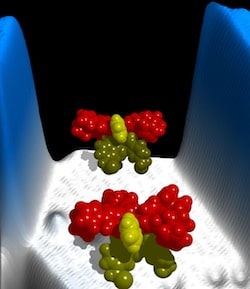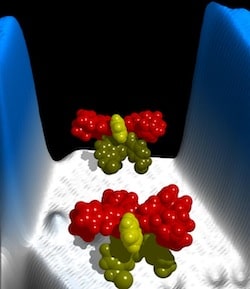
An international team of scientists has taken the next step in creating nanoscale machines by designing a multi-component molecular motor that can be moved clockwise and counterclockwise.
Although researchers can rotate or switch individual molecules on and off, the new study is the first to create a stand-alone molecular motor that has multiple parts, said Saw-Wai Hla, an Ohio University professor of physics and astronomy who led the study with Christian Joachim of A*Star in Singapore and CEMES/CNRS in France and Gwenael Rapenne of CEMES/CNRS.
It’s an essential step in creating nanoscale devices—quantum machines that operate on different laws of physics than classical machines—that scientists envision could be used for everything from powering quantum computers to sweeping away blood clots in arteries.
In the study, published in Nature Nanotechnology [abstract], the scientists demonstrated that they could control the motion of the motor with energy generated by electrons from a scanning tunneling microscope tip. The motor is about 2 nanometers in length and 1 nanometer high and was constructed on a gold crystal surface. [Watch an animation of the motor at the journal’s website here. Credit: F. Ample and C. Joachim. (Scroll down to “Supplementary information” for links to the two animations.)]
At a temperature of minus 315 degrees Fahrenheit, the motor could move independently through thermal excitation. When scientists cooled the sample to minus 450 degrees, the motor stopped rotating. The researchers selectively applied electron energy to different parts of the motor to prompt it to move clockwise and counterclockwise.
“If we want to build an actual device based on this motor, we would install electrodes on the surface to create an energy source,” Hla said.
To construct the molecular motor, the scientific team designed a stationary base of atoms that is connected to an upper moving part by one atom of ruthenium, which serves as the “ball bearing.” The upper piece of the motor features five arms made of iron atoms. The researchers made one arm shorter than the others to be able to track the motion of the machine. The entire device is held upright by using sulfur as an “atomic glue” to secure the motor to the gold surface, Hla explained.
The scientists now plan to use this model to build more complex machines with components that could be automated, Hla said.
One of the three corresponding authors is Christian Joachim, winner of the 2005 Foresight Nanotech Institute Feynman Prize for Theoretical work and one of three winners of the 1997 Foresight Nanotech Institute Feynman Prize for Experimental work.
The molecular motor consists of a single ruthenium atom bearing connecting a tripodal stator to a five-arm rotor. to help detect the motion of the rotor, the five arms are not all equivalent. The centner of the rotor is a cyclopentadiene, one short arms is merely a toluene, while the other four long arms each comprise a phenyl group connected to a ferrocene (two cyclopentadienyl rings sandwiching an iron atom). The ferrocene groups act as reversible electron relays. The four ferrocene end groups enable control of rotation by four nanoelectrodes. The tripodal stator comprises a boron atom connected to three indazolyl groups, each with a thioether foot that binds via a sulfur atom to the gold surface upon which the motor sits.
The motor was imaged using a scanning tunneling microscope (STM) under ultra high vacuum conditions (UHV). For some samples a large bias voltage pulse was used to remove the top (rotor) part of the motor, revealing the tripod stator positioned with each leg along a [211] surface direction of the Au(111) surface. At 80 K the image of the intact motor shows a uniform circle due to the free rotation of the rotor. At 4.6 K rotation has been stopped so that the asymmetric five-lobe structure of the rotor is visible, with four long arms and one short arm.
After positioning the tungsten STM tip above the center of the rotor and then gradually increasing the voltage, rotation was observed at 0.6 V due to inelastic electron tunneling energy transfer. Stepwise rotation was achieved at 4.6 K by placing the STM tip over the molecule at a fixed height for an excitation period of less than one second. The direction of rotation was determined by where the STM tip was placed: predominantly clockwise if electrons were passing through the truncated arm, and mostly counterclockwise if electron excitation was via a ferrocene arm. The authors point out that the tripodal stator lifts the rotor high enough about the gold surface so that the surface does not influence the rotation. They present semi-empirical and density functional theory calculations to explain the detailed rotational mechanisms of the motor. The results show that asymmetries in rotational energy potential lead to the observed rotations by selective excitation of different subunits of the motor. They believe this understanding “will further accelerate the development of complex and automated nanomachinery that can be operated on a material surface.”
The combination of a multicomponent molecular motor and detailed theoretical analysis to elucidate the mechanisms responsible for the action of the motor raises the hope that this work will indeed further accelerate development of complex automated molecular machinery.
—James Lewis, PhD
